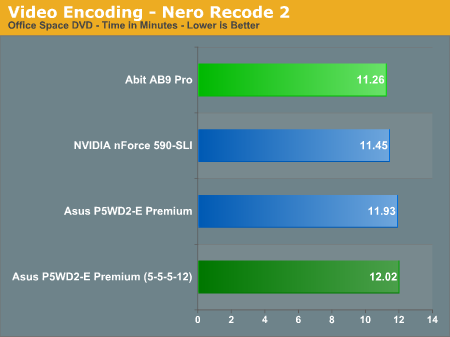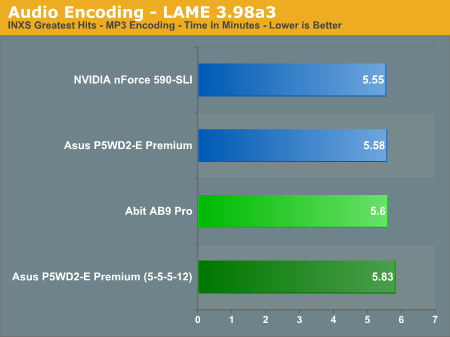Abit AB9 Pro: A sneak peek at Intel's new P965 chipset
by Gary Key on July 3, 2006 3:45 AM EST- Posted in
- Motherboards
Media Encoding Performance
For media encoding, our first test is quite easy - we take our original Office Space DVD and use AnyDVD Ripper to copy the full DVD to the hard drive without compression, thus providing an almost exact duplicate of the DVD. We then fire up Nero Recode 2, select our Office Space copy on the hard drive, and perform a shrink operation to allow the entire movie along with extras to fit on a single 4.5GB DVD disc. We left all options on their defaults except we checked off the advanced analysis option. The scores reported include the full encoding process and is represented in minutes, with lower numbers indicating better performance.

The results left us amazed with the Abit P965 board scoring 7% better than the Asus i975X board at the same memory settings while still bettering our NVIDIA board that placed first in our previous tests. We ran the benchmark several times and verified our settings before accepting the test results. It will be interesting to see if this pattern continues with other P965 based boards.
Audio Encoding Performance
While the media encoding prowess of the Abit AB9 Pro was superb in our initial media encoding testing, we wanted to see how it fared on the audio side. Our audio test suite consists of Exact Audio Copy v095.b4, LAME 3.98a3, LAME MT3.97a-MS Compiler, and Nero Digital Audio. We utilize the INXS Greatest Hits CD that contains 16 tracks totaling 606MB of one time '80s hits.
Our first test consists of utilizing Exact Audio Copy as the front end for our differing versions of LAME. We set up EAC for variable bit rate encoding, burst mode for extraction, use external program for compression, and to start the external compressor upon extraction. (EAC will read the next track while LAME is working on the previous track, thus removing a potential bottleneck with the optical drive.)
Our two versions of LAME consist of the recently released 3.98a3 and LAME MT 3.97a, which is a multi-threaded version of the LAME MP3 encoder. LAME MT was originally designed as a demonstration to show the advantages of multi-threading on the Pentium 4 with Hyper-Threading enabled. Instead of running multiple parallel threads, LAME MT generates the encoder's psycho-acoustic analysis function in a separate thread from the rest of the encoder using a simple linear pipeline. The results are presented in minutes for the encoding process, with lower numbers being better.


As in the media encoding section, the more intensive CPU and storage system tests seem to favor the P965 over the i975X when running at the same memory timings and are near that of the two results at lower memory timings. Even at this early stage we see some benefits of the reworked/enhanced memory controller on the P965. When utilizing LAME MT we see upwards of a 35% improvement in encoding times. This once again shows the advantages of programs written to take advantage of multiple-core processors.
For media encoding, our first test is quite easy - we take our original Office Space DVD and use AnyDVD Ripper to copy the full DVD to the hard drive without compression, thus providing an almost exact duplicate of the DVD. We then fire up Nero Recode 2, select our Office Space copy on the hard drive, and perform a shrink operation to allow the entire movie along with extras to fit on a single 4.5GB DVD disc. We left all options on their defaults except we checked off the advanced analysis option. The scores reported include the full encoding process and is represented in minutes, with lower numbers indicating better performance.

The results left us amazed with the Abit P965 board scoring 7% better than the Asus i975X board at the same memory settings while still bettering our NVIDIA board that placed first in our previous tests. We ran the benchmark several times and verified our settings before accepting the test results. It will be interesting to see if this pattern continues with other P965 based boards.
Audio Encoding Performance
While the media encoding prowess of the Abit AB9 Pro was superb in our initial media encoding testing, we wanted to see how it fared on the audio side. Our audio test suite consists of Exact Audio Copy v095.b4, LAME 3.98a3, LAME MT3.97a-MS Compiler, and Nero Digital Audio. We utilize the INXS Greatest Hits CD that contains 16 tracks totaling 606MB of one time '80s hits.
Our first test consists of utilizing Exact Audio Copy as the front end for our differing versions of LAME. We set up EAC for variable bit rate encoding, burst mode for extraction, use external program for compression, and to start the external compressor upon extraction. (EAC will read the next track while LAME is working on the previous track, thus removing a potential bottleneck with the optical drive.)
Our two versions of LAME consist of the recently released 3.98a3 and LAME MT 3.97a, which is a multi-threaded version of the LAME MP3 encoder. LAME MT was originally designed as a demonstration to show the advantages of multi-threading on the Pentium 4 with Hyper-Threading enabled. Instead of running multiple parallel threads, LAME MT generates the encoder's psycho-acoustic analysis function in a separate thread from the rest of the encoder using a simple linear pipeline. The results are presented in minutes for the encoding process, with lower numbers being better.


As in the media encoding section, the more intensive CPU and storage system tests seem to favor the P965 over the i975X when running at the same memory timings and are near that of the two results at lower memory timings. Even at this early stage we see some benefits of the reworked/enhanced memory controller on the P965. When utilizing LAME MT we see upwards of a 35% improvement in encoding times. This once again shows the advantages of programs written to take advantage of multiple-core processors.










33 Comments
View All Comments
mechBgon - Thursday, July 6, 2006 - link
Peak. A summit, a maximum value, etc.Peek. A quick look, a glance.
Pique. Annoyance, such as some people experience when "peak" and "peek" get swapped in full view of 2-3 million people. ;)
That is all. We now return you to your regularly-scheduled DailyTech program. :)7
JarredWalton - Saturday, July 8, 2006 - link
It just looked so nice right next to "sneak". We were debating between a "sneek peek", a "sneak peak", and a "snique pique" and you can see which one got the vote. ;)Sorry for the error - proofing thousands of words per week, stuff does slip through occasionally. On the bright side, we can fix the errors as they're caught - revisionist publishing at its best.
zsdersw - Thursday, July 6, 2006 - link
Pique can also mean to provoke or arouse.. as in: "His flashy outfit piqued my interest."commonuser - Thursday, July 6, 2006 - link
good review. particularly so as i've become increasingly interested in the direction these new platforms will take.however, i must say that i'm finding the obsession with SLI/Crossfire a bit overemphasized in every motherboard review i've read on the web as of late. now, i really do not have the exact figures at my disposal, but i'd say with a pretty high level of assumptive confidence that a significantly lower proportion of so-called "enthusiast" cyberpopulace makes use of these solutions, compared to traditional, albeit powerful single-gpu setup (think x1900xtx, or 7900gtx). "mainstream" segment falls into a non-SLI/CF category even more so...
therefore, when we have this opening sentence: , and this sentence in the conclusion: , one has to ask him/herself: what really is the difference among "enthusiast", "mainstream", "value", and/or "entry-level" chipsets and mainboards? is it soon going to be a huge oversight or a mistake if a manufacturer leaves out SLI support on a "value" or "entry-level" MB?
JarredWalton - Saturday, July 8, 2006 - link
Note the criticism is directed at *Intel* for not allowing manufacturers to make 2x8 PCIe configurations using P965. Given the cost of making that change, I would much rather have the option of using SLI/CF even if I never take advantage of it. One PCIe X16 slot is pretty much "value oriented" in my opinion these days.Kiste - Thursday, July 6, 2006 - link
Is it even possible to install WinXP from a PATA drive if the PATA port is 3rd party?I just bought a very nice BenQ PATA DVD writer and I certainly won't get rid of it just to buy Plextor's crappy SATA DVD writer or the even more abysmal one from Samsung.
Gary Key - Thursday, July 6, 2006 - link
Yes, there is limited functionality in the bios that allows the system to recognize the PATA port upon boot and for it to be utilized to load the OS or drivers if the OS is already loaded. We have seen this operation on our first two 965 boards but have one board that would not allow the PATA port to be recognized until the drivers were loaded. We were told this would be corrected in the shipping bios.goinginstyle - Tuesday, July 11, 2006 - link
Is it possible to load Linux with this IDE controller?Kiste - Thursday, July 6, 2006 - link
Ok, I'm not sure I completely understand. I can boot up with my WinXP installation CD and then I'll have to install drivers for the 3rd party PATA controller before I can install WinXP? Is that about right? Does that mean that I need a floppy drive?JarredWalton - Saturday, July 8, 2006 - link
If the BIOS is designed correctly, it can make the base XP installation detect the 3rd party IDE without drivers. Some earlier IDE chipsets didn't work (back in nF3 and ealier time frame), but most IDE and SATA solutions will now work without a driver disk. You would still need the driver disk for RAID, and certain BIOS settings might require it as well.